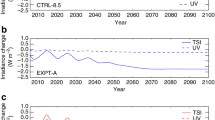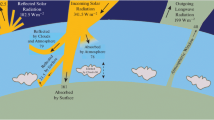Abstract
Long-wave energy emitted by the Earth-atmosphere into space is characterized by changes in power over time that always lag behind the changes in power of the absorbed solar radiation due to slow variation in enthalpy of the Earth-atmosphere system. Long-term variation of the solar energy radiation absorbed by the Earth remains uncompensated by the energy radiated into space over the interval of time that is determined by the thermal inertia. The basic state of the climate system is when the debit and credit sides in the Earth’s global annual mean energy budget (including the air and water envelopes) are almost always unbalanced. The annual mean balance of the heat budget of the Earth-atmosphere over a long time period will reliably define the behavior and magnitude of the energy excess accumulated by the Earth or energy deficit to allow us to determine adequately and to predict beforehand the trend and amplitude of the forthcoming climate change using the prognosis of variations in the total solar irradiance (solar constant). The decrease in solar constant has been observed since the early 1990s. The Earth as a planet will have a negative balance in the energy budget in the future as well, because the Sun is entering the decline phase of the bicentennial luminosity changes. This will lead to a drop in temperature in approximately 2014. The increase in albedo and decrease in greenhouse gas concentration in the atmosphere will result in the additional decrease in absorbed portion of the solar energy and reduced greenhouse effect. The additional drop in temperature exceeding the effect of decreased solar constant can occur as a result of successive feedback effects. A deep bicentennial minimum in solar constant is to be anticipated in 2042 ± 11 and the 19th Little Ice Age (for the last 7500 years) may occur in 2055 ± 11.
Similar content being viewed by others
References
Kh. I. Abdussamatov, “Long-Term Variations of the Integral Radiation Flux and Possible Temperature Changes in the Solar Core,” Kin. Phys. Celest. Bodies 21, 328–332 (2005).
Kh. I. Abdussamatov, “The Time of the End of the Current Solar Cycle and the Relationship Between Duration of 11-Year Cycles and Secular Cycle Phase,” Kin. Phys. Celest. Bodies 22, 141–143 (2006).
Kh. I. Abdussamatov, “Decrease of the Solar Radiation Flux and Drastic Fall of the Global Temperature on the Earth in the Middle of the XXI Century,” Izv. Krym. Astrofiz. Observ. 103, No. 4, 292–298 (2007).
Kh. I. Abdussamatov, “Optimal Prediction of the Peak of the Next 11-Year Activity Cycle and of the Peaks of Several Succeeding Cycles on the Basis of Long-Term Variations in the Solar Radius or Solar Constant,” Kin. Phys. Celest. Bodies 23, 97–100 (2007).
Kh. I. Abdussamatov, “The Sun Is Responsible for Climate,” Nauka i Zhizn’, No. 1, 34–42 (2009) [in Russian].
Kh. I. Abdussamatov, The Sun Dictates the Climate of the Earth (Logos, St. Petersburg, 2009. - 197 p.) [in Russian].
S. I. Avdyushin and A. D. Danilov, “The Sun, Weather, and Climate: A Present-Day View of the Problem (Review),” Geomagn. Aeron. 40, 545–555 (2000).
Climate Oscillations of the Last Millenium, Ed. by E. P. Borisenkov (Gidrometeoizdat, Leningrad, 1988. - 408 p.) [in Russian].
H. I. Abdussamatov, “About the Long-Term Coordinated Variations of the Activity, Radius, Total Irradiance of the Sun and the Earth’s Climate,” in Proceedings of IAU Symposium No. 223 (Cambridge Univ. Press, Cambridge, 2004), pp. 541–542.
H. I. Abdussamatov, A. I. Bogoyavlenskii, S. I. Khankov, and Y. V. Lapovok, “Modeling of the Earth’s Planetary Heat Balance with Electrical Circuit Analogy,” J. Electromagn. Anal. Appl. 2, 133–138 (2010).
S. Bal, S. Schimanke, T. Spangehl, and U. Cubasch, “On the Robustness of the Solar Cycle Signal in the Pacific Region,” Geophys. Res. Lett. 38, L14809–L14814 (2011).
J. A. Eddy, “The Maunder Minimum,” Science 192, 1189–1202 (1976).
W. Herschel, “Observations Tending to Investigate the Nature of the Sun, in Order to Find the Causes Or Symptoms of Its Variable of Light and Heat; with Remarks on the Use that May Possibly be Drawn from Solar Observations,” Phil. Trans. R. Soc. London 91, 265–318 (1801).
N. A. Krivova, S. K. Solanki, and T. Wenzler, “ACRIM-Gap and Total Solar Irradiance Revisited: Is There a Secular Trend between 1986 and 1996?,” Geophys. Res. Lett. 36, L20101 (2009).
J. L. Lean, “Short Term, Direct Indices of Solar Variability,” Space Sci. Rev. 94, 39–51 (2000).
M. J. McPhaden, T. Lee, and D. McClurg, “El Nino and Its Relationship to Changing Back-Ground Conditions in the Tropical Pacific Ocean,” Geophys. Res. Lett. 38, L15709–L15712 (2011).
M. Penn and W. Livingston, “Long-Term Evolution of Sunspot Magnetic Fields,” arXiv:1009.0784v1 [astro-ph.SR] (2010).
J. R. Petit, J. Jouzel, D. Raynaud, et al., “Climate and Atmospheric History of the Past 420,000 Years from the Vostok Ice Core, Antarctica,” Nature 399, 429–436 (1999).
A. I. Shapiro, W. Schmutz, E. Rozanov, et al., “A New Approach to the Long-Term Reconstruction of the Solar Irradiance Leads to Large Historical Solar Forcing,” Astron. Astrophys. 529, A67 (2011).
S. K. Solanki and N. A. Krivova, “Solar Irradiance Variations: From Current Measurements to Long-Term Estimates,” Solar Phys. 224, 197–208 (2004).
K. E. Trenberth, J. T. Fasullo, and J. Kiehl, “Earth’s Global Energy Budget,” Bull. Am. Meteor. Soc. 90, 311–324 (2009).
Author information
Authors and Affiliations
Corresponding author
Additional information
Original Russian Text © Kh.I. Abdusamatov, 2012, published in Kinematika i Fizika Nebesnykh Tel, 2012, Vol. 28, No. 2, pp. 22–33.
About this article
Cite this article
Abdusamatov, K.I. Bicentennial decrease of the solar constant leads to the Earth’s unbalanced heat budget and deep climate cooling. Kinemat. Phys. Celest. Bodies 28, 62–68 (2012). https://doi.org/10.3103/S088459131202002X
Received:
Published:
Issue Date:
DOI: https://doi.org/10.3103/S088459131202002X




